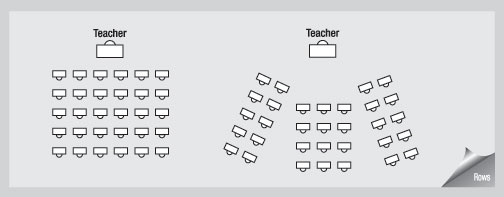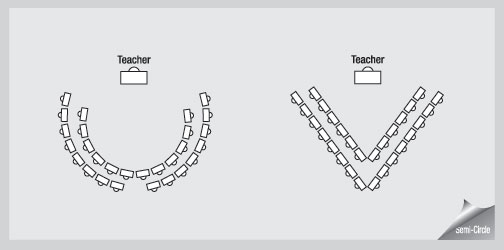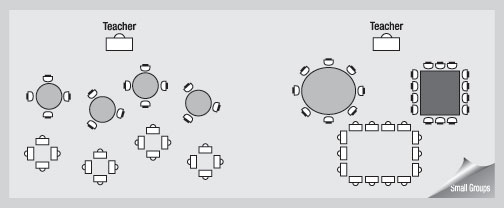 Function II: Task Completion
Function II: Task Completion
Classroom Setting Strategies Nos. 8 through 14
- No. 8: Create work areas to support specific tasks.
- No. 9: Choose the most appropriate seating arrangement for each task.
- No. 10: Provide all students with a clear line of view to instruction.
- No. 11: Design pathways to avoid congestion.
- No. 12: Locate materials and supplies in easily accessible, clearly marked storage areas.
- No. 13: Locate the teacher's desk in a convenient and appropriate location.
- No. 14: Use location anchors to alert students to pay attention to specific instructional messages.
Classroom Setting Strategy No. 8: Create work areas to support specific tasks.
Elementary classrooms typically have designated learning areas. For very young students, it may be helpful to clearly spell out the type of activity that is to be done in each area; for example, "the desks are for work, the rug is for play, and the large table is for discussion."
Secondary classrooms often consist only of rows of desks and chairs. However, providing specific areas for discussion, independent work, or small-group projects adds variety and helps focus students' attention. Bookshelves, filing cabinets, and movable dividers can all be used to establish boundaries within the classroom.
Classroom Setting Strategy No. 9: Choose the most appropriate seating arrangement for each task.
There are four main types of seating arrangements; each has advantages and disadvantages when used with various tasks. The four main arrangements are:
- Rows: Rows may be horizontal, vertical, or U-shaped.
- Semicircle: A semicircle may be V-shaped or U-shaped. It may be arranged with chairs only, or with desks and chairs.
- Small Groups or Clusters: Small groups may be arranged with chairs only, or with desks and chairs. Chairs or desks may be arranged into a few large clusters rather than into many small clusters.
- Large Circle: A large circle may be arranged with chairs only, with desks and chairs, or around a table with chairs.
No matter what seating arrangement you use, individual study stations—such as carrels or desks facing away from other desks—may be placed around the room. Individual study stations provide privacy and freedom from visual distractions.
The seating arrangements you use in your classroom send a clear message to students about your philosophy of learning. Make sure your seating arrangements match your instructional objectives. When you’re planning your seating arrangements, be sure to experiment. Seating shouldn’t be permanent; it should change with the activity and lesson. Monitor the effects of your seating pattern, and don’t be afraid to experiment with different arrangements to achieve different results.
Row Variations
In rows, students do tasks based on teacher-directed communication and activity. All eyes are on the teacher, who is the clear instructional leader. Students wait for the teacher’s direction.

| This arrangement supports: | This arrangement doesn't support: |
|---|---|
|
|
Source of row variation: Jones, Frederic H., Ph.D. Fred Jones Tools for Teaching: Discipline, Instruction, Motivation, © 2000.
Semicircle Variations
In semicircles, students learn through a combination of teacher-directed tasks and class discussions. Though the teacher leads much of the instruction, he or she also provides opportunities for student participation.

| This arrangement supports: | This arrangement doesn’t support: |
|---|---|
|
|
Small-Group or Cluster Variations
In small groups or clusters, students conduct their own learning in cooperation with a small number of classmates. Through self- and peer-directed tasks, students learn from one another while the teacher acts as a resource or a catalyst for learning.

| This arrangement supports: | This arrangement doesn’t support: |
|---|---|
|
|
Large Circle
In a large circle, students do tasks based on whole-class involvement and peer relationships. Students have a high potential for involvement and interaction. The teacher participates as a group member.

| This arrangement supports: | This arrangement doesn’t support: |
|---|---|
|
|
Classroom Setting Strategy No. 10: Provide all students with a clear line of view to instruction.
Students are more inclined to pay attention and participate when they can easily see the board and presentations without any visual interference.
Classroom Setting Strategy No. 11: Design pathways to avoid congestion.
Access to high-traffic areas such as water fountains, pencil sharpeners, and wastepaper baskets should be clearly visible and as far away as possible from students' desks. Pathways should go around rather than through work areas.
(This strategy relates to "Strategy No. 5: Arrange the room so students are free from interference, intrusions, and distractions.")
Classroom Setting Strategy No. 12: Locate materials and supplies in easily accessible, clearly marked storage areas.
Many classroom management disruptions occur when students are getting supplies to do a project or cleaning up at the end of a class period. Giving students easy access to supplies and clearly labeling where they are stored can minimize problems.
Classroom Setting Strategy No. 13: Locate the teacher's desk in a convenient and appropriate location.
In many classrooms, the teacher's desk is located at the front; however, this may not be the best place for it. Locating your desk in a back corner, for example, may allow you to confer with students one-on-one in a more discreet way, maintaining students' dignity.
Classroom Setting Strategy No. 14: Designate specific places in the room where you stand to accomplish specific instructional goals.
For example, stand in the front of the room when giving directions, stand in the center of the room when telling a story, and stand off to the side of the room when you're responding to misbehavior.
Strategies by Function
Click the images or text links below to navigate to the rest of the strategies

